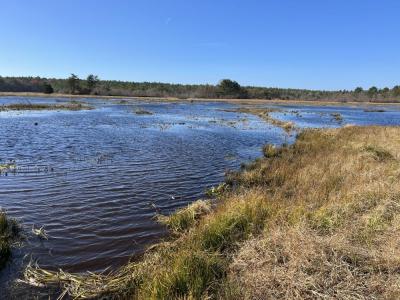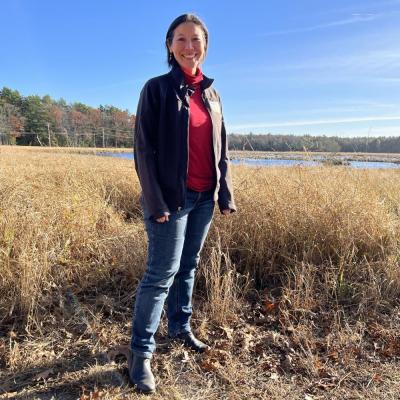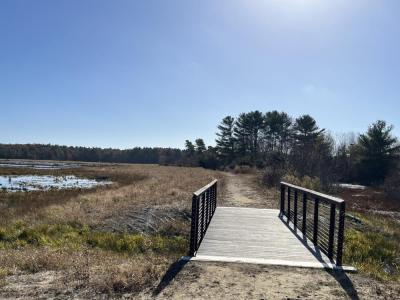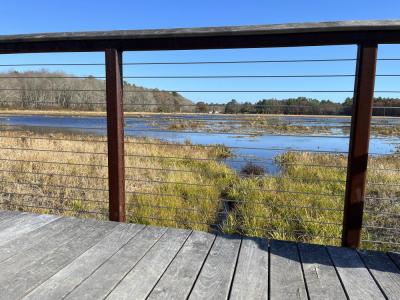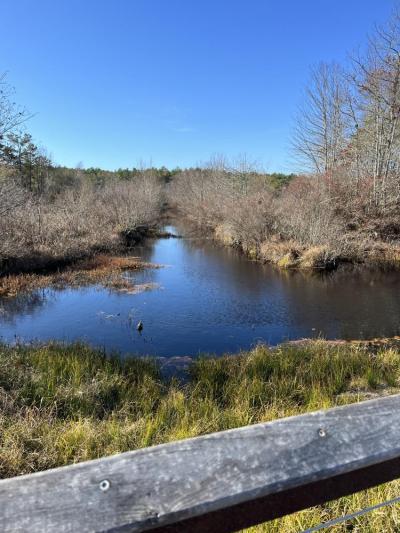Mattapoisett Bogs reopen
MATTAPOISETT — The property west of Acushnet Road had been used to cultivate cranberries for about eight decades when the nonprofit Buzzards Bay Coalition acquired it in 2011.
The Mattapoisett Bogs, as they’re known, were retired at that time from cranberry farming with an agreement between the property’s prior owner and federal government that the natural wetlands there be restored.
More than a decade later, the vision to revitalize the wetlands is nearing fruition.
The bogs, which were closed to the public for a little over a year due to construction, are back open. The wetlands have been restored, and the site’s trail network has been renovated.
Before the restoration, the 55-acre site was a “checkerboard” of dikes, ditches and manmade features, according to Buzzards Bay Coalition project manager and restoration ecologist Sara Quintal.
Removing those manmade components that had been installed at the site over the years of cranberry cultivation — the dikes, ditches, pipes, pavement — restored the wetlands’ resources and a more natural flow of water, Quintal said.
“By erasing that checkerboard and letting the water flow on its own, we really restored a resilient landscape that can roll with the punches as far as what Mother Nature has coming down the pipe,” she said.
The project also serves to restore and protect water quality and quantity of the aquifer underneath Mattapoisett — an aquifer that provides drinking water to five different towns, according to Quintal.
“Wetlands are the earth’s natural filters, so whenever you can slow water down and lead it into a wetland and let it infiltrate slowly, it has the ability to be as pure as it can be,” she said.
With the natural land revitalized, wildlife and plants have returned. Animals like salamanders and turtles and birds like egrets, mallards and killdeer are all present at the Mattapoisett Bogs. Fish are in the water. And in the wetland grow naturally occurring vegetation like water lilies and sedges, according to Quintal.
“In a single growing season, we’re really able to see life bounce back beautifully,” she said.
The steep surfaces of the 13 former cranberry bog cells and the berms between them were shaped and contoured to create shallower slopes and smoother transitions for wildlife and vegetation.
“Nature rebounds amazingly when you give it a chance,” Quintal said. “And so we basically gave it a nudge by removing those manmade elements.”
While the restoration project aims to benefit the natural land and habitats at the site, there’s also a benefit to humans — not only from the water improvements but due to the increased recreation access on the property.
Five bridges and two boardwalks installed in the property’s trails serve to make the restored wetlands “interesting and accessible” and allow people to get close to and travel over them, according to Quintal.
When the Buzzards Bay Coalition acquired the site in 2011, the requirement to restore the area’s wetlands — made between the cranberry bogs’ former owner and the U.S. Department of Agriculture’s Natural Resources Conservation Service — was a directive it went into “knowingly and enthusiastically,” but planning takes time, Quintal said.
More than a decade since the acquisition, and after a year of excavation and construction at the site, the Mattapoisett Bogs are reopened and restored. An official grand opening event with speakers and guided tours at the property is scheduled for Monday, Nov. 25 at 3 p.m.




